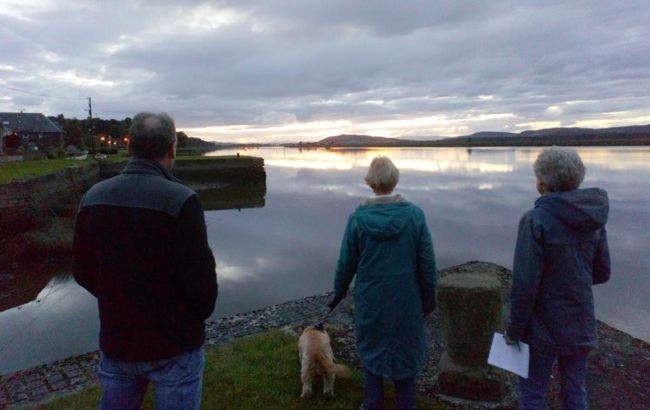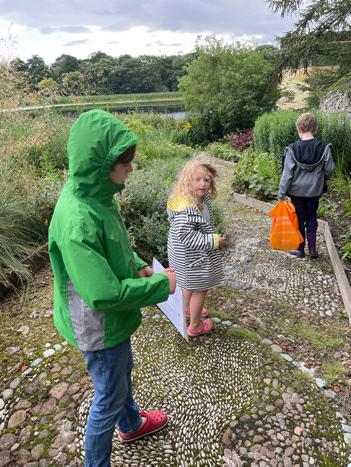COVER
Connecting to God in nature
Thomas Baldwin learns about the growth and background to experiencing church outdoors.
Thomas Baldwin
AS traditional churches in Scotland struggle to entice people through their doors, an increasing number are taking church outdoors.
They go by a number of different names, including Forest Church, Muddy Church and Messy Church Goes Wild, but all aim to offer a different experience of God through nature, especially for people who have found the formal church environment isn’t for them.
Forest Church is a UK-wide Fresh Expression that started around 10 years ago from the work of Bruce Stanley, who literally wrote the book on it – Forest Church: A Field Guide to Nature Connection for Groups and Individuals was published in 2020.
The Rev Peter Wood is the Pioneer and New Housing Co-ordinator for Lothian Presbytery. He came across Forest Church while working in England, and after moving back to Scotland he set up Penicuik Forest Church.
He says: “Forest Church is looking to provide space for worship outdoors, and to enjoy the gift of creation and to appreciate the uniqueness of every context and see in the gift of each season and to place alongside scripture the revelation of nature.
“It can cover a wide range of different activities (depending on) your context and the people that you’re working with. So some forest churches are about blokes hiking, others include families and are more like messy church outdoors.
“Penicuik has some great woods, and the Pentland Hills nearby, and it was an obvious invitation to see what Forest Church might look like in our context. Our group varies from eight, nine, ten up to 30, depending on weather and where we’re meeting. Currently we meet monthly on Sunday afternoons, although we have other activities in addition to that.
“We have husbands who wouldn’t come to church, we have dechurched people who have stopped going to church but feel that Forest Church has got a space for them – so there’ll be a mixture of people that go to church and people that don’t.”
Another newish group is ‘Muddy Church’ at Duddingston Kirk, Edinburgh. “I guess there were several motives to it,” says Reuben Addis, one of the organisers. “We were committed to finding ways to meet and worship together intergenerationally, and we were part of a new church group and were looking for some way to work more closely with those churches. (The groupings have since changed, but the Muddy Church continues.) We also wanted something outside, as we were in lockdown at the time.
“Although these more prosaic reasons provided the context for our fresh expression – there was something really compelling about the idea when it was suggested. We were all thinking a lot about the churches’ response to the environmental crisis with Cop26 [the 2021 climate conference in Glasgow] looming, and also developing a spirituality around worshipping God outside (and) I had been really moved by outside events both at Greenbelt and at Solas. We had also done some outside worship in Messy Church.
“We meet at about 11am on the first Saturday of every month on the grass outside Duddingston Kirk. We generally start with a gathering activity to welcome people and to set the theme. We have a couple of activities on offer (building bird nests, a treasure hunt, building a bonfire, etc) as well as an encouragement to spend time in the gardens and notice and wonder. We’ll often also have a prayer themed on the story at that point (often a stilling activity or something grounding as well as an acknowledgement of God’s presence with us) as part of the welcome.

The Howe of Fife Forest Church

Muddy Church
“We gather again at about 12 for a bible story and more chat and prayer – usually sharing what we found or what we felt God saying to us. It’s a really small informal gathering and people have started to bring sandwiches and hang around together for longer (especially if the weather is warm).
“It feels a lot less difficult to organise than more traditional children’s work – fewer activities and the children are calmer because of the space. It also works well for adults, who share the gathering prayer and story, but often chat or pray on their own during the less structured time.”
Possibly the oldest Forest Church in Scotland is in Howe of Fife, in the rural north of the Kingdom, where the Rev Bill Hunter has been running a group ‘for a number of years’. “I read Bruce Stanley’s book, it made sense so I thought ‘I’ll try it and see what happens’,” he says.
“So many people say they connect to God in nature, and the whole premise of Forest Church is responding to that spiritual energy that people get from being in and connected to nature. The whole substance of it is meeting God through God’s first book, the book of creation.”
Previously meeting on the traditional quarter days and sun festivals, last year Bill increased the gatherings to monthly. “What I try to do is look at what’s going on in the natural world, think about the nature of the traditional festivals, whether that’s the sun festivals – solstices and equinoxes – or the quarter days, and see what traditionally people did. And given that we’re in a big rural area, connections to planting and sowing, reaping and harvest come naturally in a way they don’t in the cities.
“
So many people say they connect to God in nature, and the whole premise of Forest Church is responding to that spiritual energy that people get from being in and connected to nature.
“One of the nice things we talk about is leaves coming off the trees so the trees can take the energy into themselves, and thinking about how can I take in the energy I need to get through the darkness. We’ve taken bulbs and planted them and I’ve invited people to use an autumn leaf to plant them in so life and death are connected.
“We’ve climbed hills, we’ve gone to forests, we’ve gone to the seashore. In Newburgh they’ve got a community orchard, so that was a nice place to go towards the end of the year when the apples were ripe, to talk about gathering in and storing up.”
Bill admits that some elements of Forest Church may be seen as ‘terribly pagan and awful’ by some in the traditional church.
“I think partly it’s to do with the Reformation and that rethinking of faith, and partly to do with urbanisation, so we’ve lost that connection with the rhythms of nature.
“But actually, if you ask folk they say they feel God in nature – if I’m up the hills, or at the seashore, or looking up at the stars at night I have a sense of God’s presence. That whole connection with creation, I don’t see it as necessarily pagan or whatever… I come at it as someone who believes that God is behind all creation, that God is present in creation, and therefore what God does through creation helps us to understand Him in another way.
“And at the same time, I’m doing Sunday mornings, and getting the rhythm of the Christian year. It’s not either/or. It’s just a different way of seeing things that speaks to different people.” ¤
For more information on Forest Church, contact Peter Wood on pwood@ churchofscotland.org.uk. There is a national Forest Church Facebook group, and individual groups have their own pages and websites.